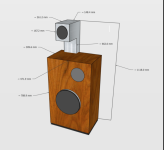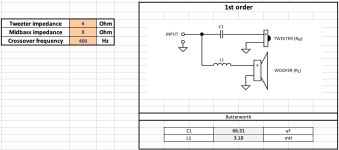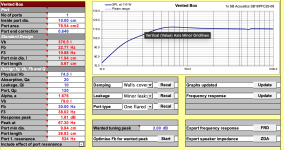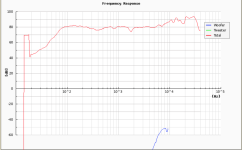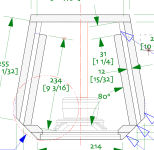Hi diyers,
Having just completed my first fullrange design (pensils with Markaudio Pluvia 7.2HD), I'm planning a woofer assisted wideband (WAW) in order to maximise output and get deep, tight bass. It's following a specific visual design (courtesy of a furniture designer who is in on the project) – see next post. A benefit of the design is that it lends itself to time aligned drivers. I'm not trying to achieve audiophile grade sound, and I don't want to break the bank, but I'd like to produce speakers worth the build/money (and then some?).
In the large cabinet, the Peerless SLS-P830669 seems like a good option. I'm planning to build the cabinet out of 25mm baltic birch ply. Once bracing, port, and driver are accounted for, I'm estimating a net internal volume of 74.5L. I have modelled this with a tuning of 30hz to give an F3 of about 38hz (simulation chart in next post). Up in the sealed 'periscope' part of the speaker, I would ideally use the familiar Pluvia 7.2HD driver. However, I'm keeping in mind that I may need a larger driver to work well with the 12" woofer, so I am also considering the Pluvia 11 (or Alpair 10.3?).
I understand that WAWs are suited to simple crossovers, and I can't access any crossover modelling software because I don't have a PC! (Wine isn't working for me...) So I'm considering using a 66.31uF capacitor for the high pass and a 3.18mH inductor for the lowpass, as suggested by a rudimentary online calculator for a 1st order crossover at 400hz (diagram in next post). However, I'm reluctant to do this build without properly simulating the crossover!
I would love to get feedback/thoughts from the diyaudio community, if anyone cares to jump in. Is this speaker worth building? I have a few specific concerns and questions:
Lewis
Having just completed my first fullrange design (pensils with Markaudio Pluvia 7.2HD), I'm planning a woofer assisted wideband (WAW) in order to maximise output and get deep, tight bass. It's following a specific visual design (courtesy of a furniture designer who is in on the project) – see next post. A benefit of the design is that it lends itself to time aligned drivers. I'm not trying to achieve audiophile grade sound, and I don't want to break the bank, but I'd like to produce speakers worth the build/money (and then some?).
In the large cabinet, the Peerless SLS-P830669 seems like a good option. I'm planning to build the cabinet out of 25mm baltic birch ply. Once bracing, port, and driver are accounted for, I'm estimating a net internal volume of 74.5L. I have modelled this with a tuning of 30hz to give an F3 of about 38hz (simulation chart in next post). Up in the sealed 'periscope' part of the speaker, I would ideally use the familiar Pluvia 7.2HD driver. However, I'm keeping in mind that I may need a larger driver to work well with the 12" woofer, so I am also considering the Pluvia 11 (or Alpair 10.3?).
I understand that WAWs are suited to simple crossovers, and I can't access any crossover modelling software because I don't have a PC! (Wine isn't working for me...) So I'm considering using a 66.31uF capacitor for the high pass and a 3.18mH inductor for the lowpass, as suggested by a rudimentary online calculator for a 1st order crossover at 400hz (diagram in next post). However, I'm reluctant to do this build without properly simulating the crossover!
I would love to get feedback/thoughts from the diyaudio community, if anyone cares to jump in. Is this speaker worth building? I have a few specific concerns and questions:
- Fullrange power handling/output. I'd like these speakers to run loud. I understand the high pass on the FR driver should allow it to go a lot louder than if it were tackling lower frequencies too, but would the Pluvia 7.2 be outmuscled by the Peerless 12"? Would the speaker produce a slightly feeble output for something of its size as a result? Should I therefore use the larger Pluvia 11 driver?
- Is 400hz the right crossover frequency here? I'm trying to protect the critical frequencies above 400hz, but also wanting to squeeze as much output as possible from the fullrange, so not wanting to go too low. There's a bit of a dip in the Pluvia's frequency response at 400hz, but this seems to be compensated in my baffle step simulation (a 2db peak at the same frequency).
- Would anyone be up for doing a quick simulation of my suggested crossover network?! I might be able trace the frequency responses if that would make life easier.
- Bracing – how elaborate do I need to go? I had planned to go with something fairly basic, like two shelf style braces with four cutouts.
- Do I need to worry about minimum phase or polar response? I don't really know what these terms mean.
- Finally, I have two options for the port. (1) A cylindrical/round port, 100mm diameter, 268mm long, with a bend in order to fit. (2) A slot port, 422mm wide, 25mm high, and 387mm long. Any preference? The slot seems easier.
Lewis
Last edited:
A benefit of the design is that it lends itself to time aligned drivers
In a WAW as long as the XO is lower than a quarter wavelength of the driver centre-to-centre then the drivers are already essentially time aligned (the XO needs to be as well).
Wire the XO in series and you probably have a better XO considering the guess for values. But what woofer are you using?
Is the FR sitting in the periscope? It looks too far away from the woofer.
dave
Hmm, ~1" thick BB ply won't need any bracing, just a mass loading brace for the driver.
Re XO point, FWIW the half power point of a 75 pc. orchestra is 500 Hz, so considering the Pluvia is only a ~ 20 W, 3" driver limited to ~102 dB/m/stereo or ~82 dB average it seems a nice, safe, place though in a 2pi sim it can be XO'd as low as 150 Hz/2nd (tracking Xmax, not a good plan for SQ IME), otherwise 300 Hz 2nd, 500 Hz/3rd, 1200 Hz/1st (too high for the woofer) in a max flat 9.5 L sealed and ideally want the woofer to be +6 dB, so at ~93 dB/stereo (ignoring the room) will be just loafing along at fractional power, so plenty of high SQ tuning power available.
In short, no clue about the MA drivers when run at their limit for any length of time (loud), but for me the pioneer's 500 Hz XO for two way is a done deal based on its specs.
Re XO point, FWIW the half power point of a 75 pc. orchestra is 500 Hz, so considering the Pluvia is only a ~ 20 W, 3" driver limited to ~102 dB/m/stereo or ~82 dB average it seems a nice, safe, place though in a 2pi sim it can be XO'd as low as 150 Hz/2nd (tracking Xmax, not a good plan for SQ IME), otherwise 300 Hz 2nd, 500 Hz/3rd, 1200 Hz/1st (too high for the woofer) in a max flat 9.5 L sealed and ideally want the woofer to be +6 dB, so at ~93 dB/stereo (ignoring the room) will be just loafing along at fractional power, so plenty of high SQ tuning power available.
In short, no clue about the MA drivers when run at their limit for any length of time (loud), but for me the pioneer's 500 Hz XO for two way is a done deal based on its specs.
That's always the second step, after having selected the drivers they'll have to project the sound ahead.Is the FR sitting in the periscope? It looks too far away from the woofer.
For the crossover you either have to add an RC link to the woofer or the slope will be anything but 6dB.
For a 6dB filter to resemble it's theoretical mode of action the drivers has to be linear to at least two octaves past the crossover point So a woofer that works well to 1600 Hz and a wide range driver that works well down to 100 Hz?
Regarding high quility ply in Sweden. The problem is not getting it, it's paying for it😱
For a 6dB filter to resemble it's theoretical mode of action the drivers has to be linear to at least two octaves past the crossover point So a woofer that works well to 1600 Hz and a wide range driver that works well down to 100 Hz?
Regarding high quility ply in Sweden. The problem is not getting it, it's paying for it😱
Thanks everyone for your tips! I have a few questions (apologies, I’m still getting to grips with some of the terminology).
Of this. What are SQ, 2pi, and IME? From what I understand, you’re suggesting a 500hz 1st order XO, or maybe 300hz 2nd order. But I’m not clear on the rationale sorry! And what is the pioneer XO?
Thanks again!
Could you explain the point about wiring the XO in series any more? The woofer i have in mind is this, but I’m open to other suggestions: https://www.soundimports.eu/en/peer...ihj_B9VdwacMPt1yMob8tHyZyBQdVpDcaAglQEALw_wcBWire the XO in series and you probably have a better XO considering the guess for values. But what woofer are you using?
That’s the plan, yes. Is it going to cause notable problems? Or is it a question of the two sound sources just sounding quite separate? I’m keen to retain the periscope design but could move the woofer up a bit and maybe shorten the gap.Is the FR sitting in the periscope? It looks too far away from the woofer.
I’m afraid I’m not totally clear on somebut for me the pioneer's 500 Hz XO for two way is a done deal based on its specs.
Of this. What are SQ, 2pi, and IME? From what I understand, you’re suggesting a 500hz 1st order XO, or maybe 300hz 2nd order. But I’m not clear on the rationale sorry! And what is the pioneer XO?
To me, it looks like the woofer is linear on axis to 1600hz/2 octaves above the 400hz intended crossover (although not 2 octaves above the suggested 500hz XO). I think the driver choice seems okay, but do you think I should go for a 2nd order/12dB XO to be safe? And what is an RC link, please?For the crossover you either have to add an RC link to the woofer or the slope will be anything but 6dB.
For a 6dB filter to resemble it's theoretical mode of action the drivers has to be linear to at least two octaves past the crossover point So a woofer that works well to 1600 Hz and a wide range driver that works well down to 100 Hz?
Thanks again!
Ah yes, forgot about this rule of thumb. My suggested woofer is +3.5dB. Do you think a resistor on the full range would suffice to effectively lower its sensitivity enough? Do I need to go with a more sensitive woofer? The Dayton DS315-8 12" is better (+5.3dB) in this regard, and cheaper, but it’s not very available in the UK/EU.ideally want the woofer to be +6 dB
And sorry, I thought I understood this but I don’t! Could you clarify what a mass loading brace is? Is it the kind of brace which touches the back of the driver and runs back to front/top to bottom?~1" thick BB ply won't need any bracing, just a mass loading brace for the driver
Thanks everyone
I’m afraid I’m not totally clear on some
Of this. What are SQ, 2pi, and IME? From what I understand, you’re suggesting a 500hz 1st order XO, or maybe 300hz 2nd order. But I’m not clear on the rationale sorry! And what is the pioneer XO?
You're welcome!
SQ = sound quality
2pi is a space loading type
IME = in my experience
No and actually wrote it up wrong, so confused me at first too

 i.e. 'otherwise 500 Hz/3rd, 300 Hz/2nd, 1200 Hz/1st order' in that we want the XO to be at least -24 dB @ Fs, so based on octave spreads, 500 Hz requires 3rd order, but for your low power app a 2nd order maybe sufficient, though best if someone checks in VituixCad.
i.e. 'otherwise 500 Hz/3rd, 300 Hz/2nd, 1200 Hz/1st order' in that we want the XO to be at least -24 dB @ Fs, so based on octave spreads, 500 Hz requires 3rd order, but for your low power app a 2nd order maybe sufficient, though best if someone checks in VituixCad.'Pioneers' as in the folks that invented modern sound reproduction (Western Electric, Bell Labs) to the point initially that over the decades since the mid 1930s any major advances have only been through increasing materials, manufacturing technology, or as the inventor Tom Danley laments, 'the ancients keep stealing all my inventions'!
Normally this is done in the XO, though best to have as much acoustic efficiency as practical to ensure peak SQ performance through the critical speech BW, i.e. the woofer at least +6 dB and preferably higher and shelve it if need be.Ah yes, forgot about this rule of thumb. My suggested woofer is +3.5dB. Do you think a resistor on the full range would suffice to effectively lower its sensitivity enough? Do I need to go with a more sensitive woofer?
from Dinsdale hence the reference to horns.
2π to 4π is what we talk about as the frequency being reproduced decreases and the front baffle is no longer large enuff to support 2π space, and we get a transition called baffle step diffraction to full 4π radiation.
dave
Thank you Chris. If you have any photos, I'd love to see, just to confirm I know what you're talking about (I'm fairly sure I do). Couple of questions though: the 'centre line' refers to the centre of the driver, not the cabinet, right? And does the brace have to go all the way back to the rear panel, or can it be shorter? I've been thinking about building these with removable back panels.Lewis, that’s the strategy executed in my numerous builds of Dave & Scott’s designs. Offset the holey bracing sufficiently that one face is on the vertical centre line, and line that face with thin layer of fibrous batting.
Right, thank you again GM! So, the Pluvia's Fs being approx 75hz, I should go for a XO that diminishes the frequency response by 24dB at 75hz? I think I've misunderstood because by my workings that would mean a -12/db per octave XO anywhere from 300hz upwards... Sorry this is all obviously quite new to me. In any case, a 500hz (wavelength 69cm) XO will mess with my time alignment using the current cabinet dimensions (drivers 77cm apart, centre to centre). And going 2nd-3rd order starts to make things more complicated. How crucial is it to go with a 500hz/2nd-3rd XO, in your view? Fwiw, I found this online crossover simulator (can't speak to reliability...) which generated a nice looking frequency response with a 400hz/1st XO, plus an 11ohm resistor on the high-pass! (Pic attached.) Is there something I'm missing?want the XO to be at least -24 dB @ Fs
Okay, I'll have a look for a different woofer – thank you. If I can't find one at a reasonable price and availability (I've struggled so far), do you think I should rethink altogether, or would the resistor approach be okay? I'm not tooooo fussed of the end result needs a fair bit of power to drive it, as long as the sound is good.Normally this is done in the XO, though best to have as much acoustic efficiency as practical to ensure peak SQ performance through the critical speech BW, i.e. the woofer at least +6 dB and preferably higher and shelve it if need be.
Thank you Dave. Apologies, I'd forgotten the '2pi/' naming, but I'm familiar with this stuff.2π to 4π is what we talk about as the frequency being reproduced decreases and the front baffle is no longer large enuff to support 2π space, and we get a transition called baffle step diffraction to full 4π radiation.
I'm not sure I've totally understood everything, but overall it's sounding like this project might be worth building? More a question of building well (bracing) and getting the XO right? And I think I'll build a test 'periscope' with the Pluvia 7.2 that I already own, then I can decide about upgrading to a Pluvia 11 if the 7.2 isn't loud enough.
Regarding the build, all ply is absurdly expensive at the moment. I'm wondering if 25mm/1in mdf might do the trick. Still very stiff at that thickness, right? I know BB ply is the gold standard, but it would cost £240-250 just to buy the external walls of one bass cabinet, 18mm OR 25mm! Any guidance on finding a compromise?
Attachments
all ply is absurdly expensive at the moment. I'm wondering if 25m5mm us suffim/1in mdf might do the trick
given the amount of effort, i would still buy ply. 15mm should be sufficient. The only benefit of using the thick MDF is thatthe material leaves more room for a larger chamfer.
dave
Per Dave’s drawing above, the brace would ideally extend to couple the front and rear panels as well as top and bottom, and can still allow for removable rear panel, as in the case of the attached photo of my A7 Pensil build. Note the cleating around the perimeter which with closed cell foam weatherstripping tape provided necessary sealing, as well as an interlocking side to side brace at the lower section of enclosure. Sorry that I don’t have a lot of interior construction detail photos at hand.
With a bit more futzing around, the same approach can be used on shapes other than simple rectangular monkey coffins.
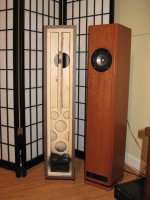 .
. 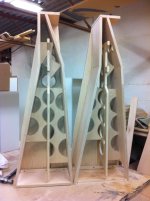
With a bit more futzing around, the same approach can be used on shapes other than simple rectangular monkey coffins.
 .
. 
Last edited by a moderator:
Right, thank you again GM! So, the Pluvia's Fs being approx 75hz, I should go for a XO that diminishes the frequency response by 24dB at 75hz?
I think I've misunderstood because by my workings that would mean a -12/db per octave XO anywhere from 300hz upwards... Sorry this is all obviously quite new to me. In any case, a 500hz (wavelength 69cm) XO will mess with my time alignment using the current cabinet dimensions (drivers 77cm apart, centre to centre). And going 2nd-3rd order starts to make things more complicated. How crucial is it to go with a 500hz/2nd-3rd XO, in your view? Fwiw, I found this online crossover simulator (can't speak to reliability...) which generated a nice looking frequency response with a 400hz/1st XO, plus an 11ohm resistor on the high-pass! (Pic attached.) Is there something I'm missing?
You're welcome!
To be 'safe' enough, yes.
'Upwards', not per se, just up to 1200 Hz/1st.
Well, IME with a woofer + mids/HF horn systems, a 3/2 XO is required to be able to wire the horn in positive polarity when its acoustic center isn't in vertical alignment with the woofer's, so for folks like me that are sensitive to proper phasing it's a big deal, IOW; the female's superior hearing is the key to an excellent audio system IME when there's one in the listening group. Like the old saying goes, 'when mama's happy, everybody's happy and when not, nobody's happy'

How crucial? It's just good engineering from an acoustic power sharing POV, but the pioneers also used 800, 1000, 1200, 1600 Hz/2nd in prosound and up to 3500 in consumer apps, so just depends on one's performance goals.
That's the problem with basic calculators in that they're only as technically good as the user. 🙁 Consider that driver excursion increases at 6 dB/octave (4x!), so doesn't take many octaves to eat up Xmax even at low power and below Fs there's no driver control, so can flop around to destruction at high power, hence the need to work it out if you want to see just how low you can go with any XO. That, or as you noted, use a high pass (AKA TT rumble filter) to protect it down low.
I had not seen what the inside of the Facets look like. :^)
what they look like now.
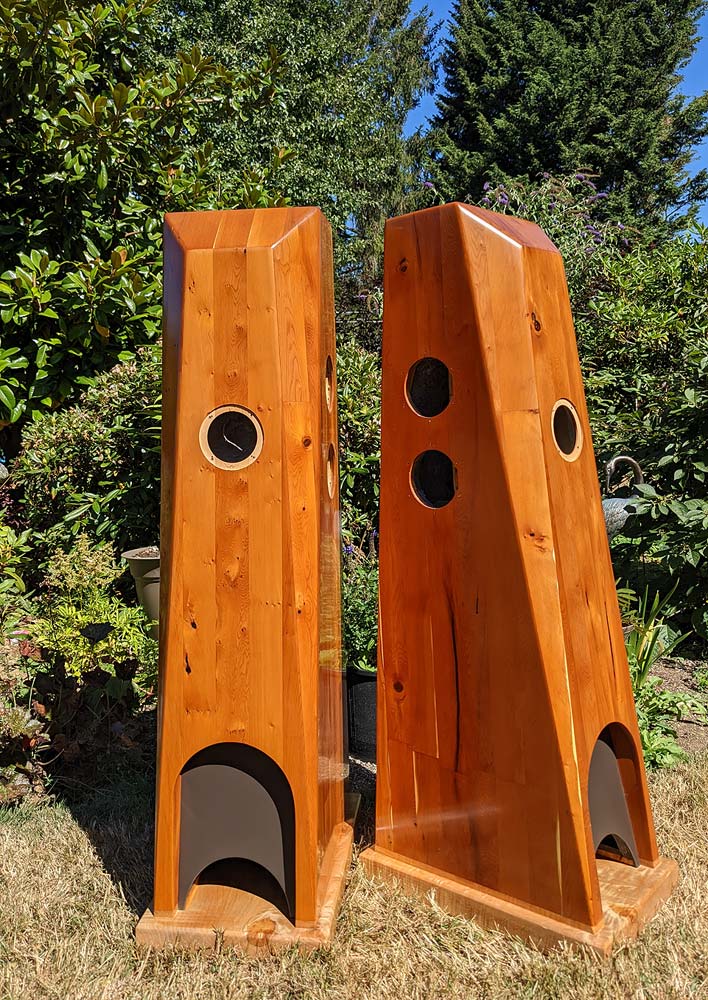
Thanx.
what they look like now.

Thanx.
Last edited:
I did build similar waw, but used other drivers, mainly a bigger fullrange driver that goes lower on it's own in a sealed cabinet. I used the Mark Audi Alpair 10.3 in a sealed top and the Scanspeak 26W8534G00 woofer in a sealed bass cabinet with the crossover at 250Hz in a 1st order serial config. F6 (what matter for sealed) is 32Hz without any eq like this. This picture is from when i did do the crossover, in my old house about 6 years ago or so...

The crossover is the weak point, and i will redo it probally, to a 2nd order crossover and time/phase aligned. But the crossover that low is important to keep the fullrange feel. I think 300Hz is about the limit (altough Dave says higher). Higher can be better done with a tweeter or mid and tweeter driver config as your crossover gets in the passband where we don't want it with fullrange drivers.
The crossover is the weak point, and i will redo it probally, to a 2nd order crossover and time/phase aligned. But the crossover that low is important to keep the fullrange feel. I think 300Hz is about the limit (altough Dave says higher). Higher can be better done with a tweeter or mid and tweeter driver config as your crossover gets in the passband where we don't want it with fullrange drivers.
- Home
- Loudspeakers
- Full Range
- Big, strange WAW project
